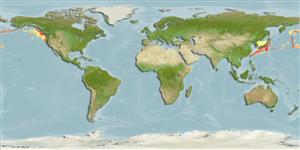>
Lophiiformes (Anglerfishes) >
Oneirodidae (Dreamers)
Etymology: Bertella: After Erik Bertelsen (1912-1993) who served as curator of the 'Dana' collections at Danmarks Fiskeri-og Havundersøgelser, Charlottenlund, Denmark. (Ref.86949).
Environment: milieu / climate zone / depth range / distribution range
Ekologi
marina djupbottenlevande; djupintervall 805 - 3475 m (Ref. 58018). Temperate; 55°N - 14°N (Ref. 123295)
Pacific Ocean.
Size / Vikt / Age
Maturity: Lm ? range ? - ? cm
Max length : 10.2 cm SL hane/ej könsbestämd; (Ref. ); 8.4 cm SL (female); common length :559 cm TL (female)
Short description
Morfologi | Morfometri
Mjukstrålar i ryggfenan (totalt): 5-6; Mjukstrålar i analfenan: 4 - 5. Metamorphosed females distinguished by the following characteristics: hyomandibular bone with single head; wide ethmoid cartilage and vomer, wider than distance between anterolateral tips of lateral ethmoids and frontals; presence of vomerine teeth in juvenile, lost with growth in adults; depressed ethmoid region, narrow and oval nasal foramina; frontals long and anterior in position, overhanging and extending past the anterior limits of the ethmoid cartilage and vomer; nearly linear dorsal margin of frontals; ventromedial extensions of the frontals approach each other on midline, making contact with parasphenoid; frontals separated from prootics; presence of pterosphenoid anterior end of illicial trough is wider and shallower than posterior end; well developed sphenotic spines; well developed symphysial spine on lower jaw; well developed quadrate spine; deeply notched posterior margin of opercle; long and narrow subopercle, dorsal end slender and tapering to a point, oval ventral end; absence of first pharyngobranchial; reduced and toothless second pharyngobranchial; second hypobranchial absent; caudal fin rays without internal pigmentation; illicium longer than length of esca bulb; pterygoiphore of illicium cylindrical throughout its length, emerging on snout from between frontal bones, anterior end slightly exposed, posterior end concealed beneath skin; well developed first ray of dorsal fin; dorsal fin rays 5-6; anal fin rays 4-5; short and broad pectoral fin lobe, shorter than longest rays of pectoral fin; pectoral fin rays 18-22; coracoid lacking posteroventral process; simple pelvic bones, with or without distal expansion; skin smooth and naked, without dermal spinules; darkly pigmented skin of caudal peduncle extends well past base of caudal fin (Ref. 86949).
Also caught with plankton nets.
Life cycle and mating behavior
Könsmognad | Reproduktion | Lek | Ägg | Fecundity | Larver
Masuda, H., K. Amaoka, C. Araga, T. Uyeno and T. Yoshino, 1984. The fishes of the Japanese Archipelago. Vol. 1. Tokai University Press, Tokyo, Japan. 437 p. (text). (Ref. 559)
IUCN Red List Status (Ref. 130435)
Threat to humans
Harmless
Human uses
Ytterligare information
PopulärnamnsynonymerMetabolikPredatorerEkotoxikologiReproduktionKönsmognadLekSpawning aggregationFecundityÄggEgg development
Age/SizeTillväxtLength-weightLength-lengthLength-frequenciesMorfometriMorfologiLarverLarvdynamikRekryteringAbundansBRUVS
referenserVattenbrukVattenbruksprofilAvelslinjerGenetikElectrophoresesÄrftlighetSjukdomarBehandlingNutrientsMass conversion
MedarbetareBilderStamps, Coins Misc.LjudCiguateraHastighetSimsättGälytaOtolithsHjärnstorlekSyn
Verktyg
Special reports
Download XML
Internet-källor
Estimates based on models
Preferred temperature (Ref.
123201): 2.1 - 3, mean 2.4 °C (based on 30 cells).
Phylogenetic diversity index (Ref.
82804): PD
50 = 1.0000 [Uniqueness, from 0.5 = low to 2.0 = high].
Bayesian length-weight: a=0.01995 (0.00906 - 0.04395), b=3.01 (2.83 - 3.19), in cm total length, based on all LWR estimates for this body shape (Ref.
93245).
Trofisk nivå (Ref.
69278): 3.7 ±0.5 se; based on size and trophs of closest relatives
Resiliens (Ref.
120179): Hög, lägsta populationsfördubblingstid mindre än 15 månader (Preliminary K or Fecundity.).
Fishing Vulnerability (Ref.
59153): Low vulnerability (10 of 100).
